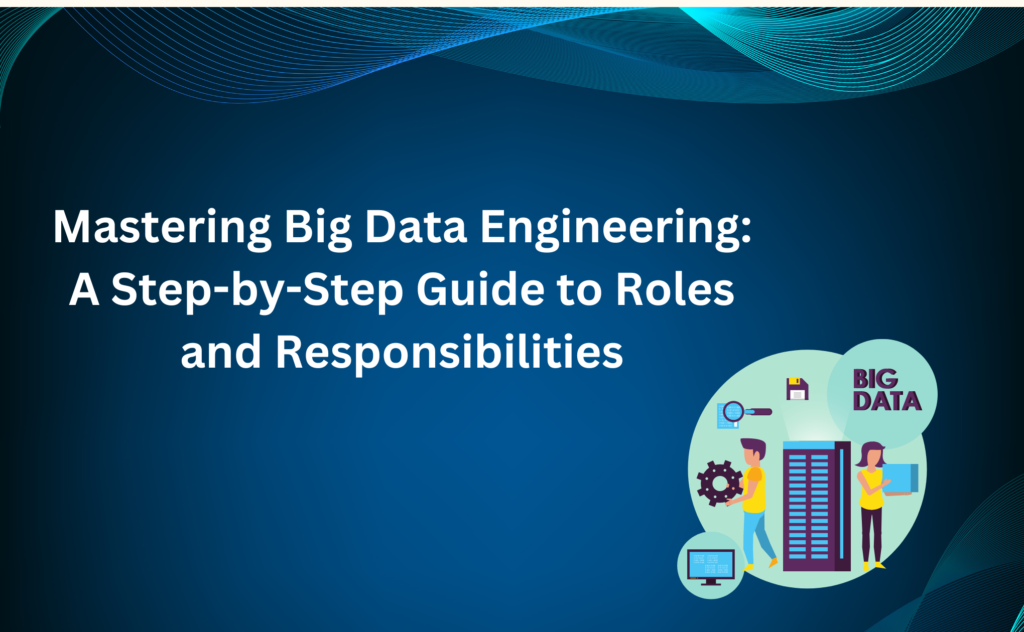How to Become a Big Data Engineer: Roles, Responsibilities, and Step-by-Step Guide

Introduction:
In the era of data-driven decision-making, the role of a Big Data Engineer has become increasingly crucial. These professionals are responsible for designing, building, and maintaining the infrastructure required to store, process, and analyze vast amounts of data. If you aspire to become a Big Data Engineer, this blog will guide you through the roles, responsibilities, and the steps to embark on this exciting career path.
Roles and Responsibilities of a Big Data Engineer:
Before diving into the path to becoming a Big Data Engineer, let’s understand what the job entails:
- Data Architecture: Big Data Engineers are responsible for designing and building data pipelines and architectures that can handle the volume, variety, and velocity of data. This includes selecting appropriate databases, storage systems, and data processing frameworks.
- Data Ingestion: They gather data from various sources, such as databases, APIs, logs, and streaming platforms, and ensure its smooth ingestion into the data infrastructure.
- Data Transformation: Big Data Engineers clean, transform, and preprocess data to make it suitable for analysis. This involves tasks like data cleaning, normalization, and aggregation.
- Data Storage: They choose and implement storage solutions like Hadoop Distributed File System (HDFS), NoSQL databases, or cloud-based storage to efficiently store massive datasets.
- Data Processing: Big Data Engineers use technologies like Apache Spark, Apache Flink, or Hadoop MapReduce to process and analyze data at scale.
- Data Security: Ensuring the security and privacy of data is a critical responsibility. This involves implementing access controls, encryption, and compliance with data protection regulations.
- Performance Optimization: They continuously optimize data pipelines and processing jobs to enhance performance and reduce latency.
- Monitoring and Troubleshooting: Big Data Engineers monitor data pipelines and infrastructure for issues, and they troubleshoot and resolve problems promptly to minimize downtime.
- Collaboration: Collaboration with Data Scientists, Analysts, and other stakeholders is essential to understand data requirements and deliver actionable insights.
Step-by-Step Guide to Becoming a Big Data Engineer:
Here’s a structured approach to kick-start your journey toward becoming a Big Data Engineer:
Step 1: Build a Strong Foundation in Computer Science:
- Start with a bachelor’s degree in computer science, software engineering, or a related field.
- Learn programming languages such as Python, Java, or Scala.
- Gain proficiency in data structures and algorithms.
Step 2: Master Big Data Technologies:
- Familiarize yourself with key Big Data technologies like Hadoop, Spark, Kafka, and NoSQL databases.
- Take online courses or enroll in a Big Data certification program.
Step 3: Learn Database Management:
- Understand database systems, both traditional SQL databases and NoSQL databases like MongoDB and Cassandra.
- Learn how to design and optimize databases for performance.
Step 4: Gain Experience with Data Processing Tools:
- Practice using data processing frameworks like Apache Spark and Apache Flink for data transformation and analysis.
- Experiment with data visualization tools like Tableau or Power BI.
Step 5: Develop Programming Skills:
- Master scripting languages such as Python for data manipulation and automation.
- Gain proficiency in using shell scripting for managing data pipelines.
Step 6: Learn Cloud Computing:
- Familiarize yourself with cloud platforms like AWS, Azure, or Google Cloud, as many Big Data projects are hosted on these platforms.
Step 7: Work on Real Projects:
- Apply your skills by working on personal or open-source Big Data projects.
- Seek internships or entry-level positions to gain hands-on experience.
Step 8: Stay Updated:
- Keep up with the rapidly evolving field of Big Data by reading blogs, attending conferences, and participating in online forums.
Step 9: Networking:
- Build a network of professionals in the field through LinkedIn, meetups, and industry events.
Step 10: Pursue Advanced Degrees (Optional):
- Consider pursuing a master’s degree or certifications in Big Data or related fields for career advancement.
Conclusion:
Becoming a Big Data Engineer is an exciting journey that requires dedication, continuous learning, and practical experience. With the right foundation, technical skills, and a passion for working with data, you can embark on this rewarding career path and play a pivotal role in the world of data-driven decision-making.

Leave a Reply